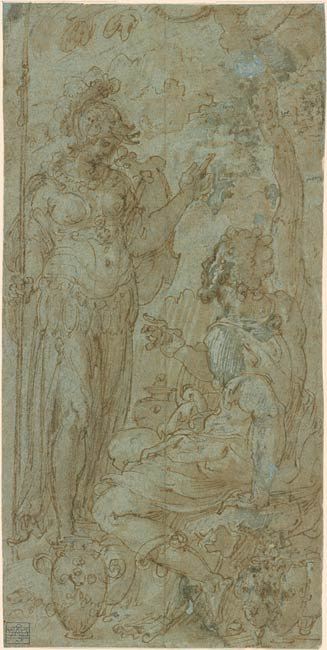
The drawing, which was one of the earliest acquired by Janos Scholz, entered the Morgan’s collection with its current attribution to Prospero Fontana. Fontana collaborated with Giorgio Vasari on numerous projects, including, in 1563-65, the decoration of the ceiling of the Sala Grande, also known as the Salone dei Cinquecento, in the Palazzo Vecchio. The draftsmanship of the Morgan study reflects Fontana’s knowledge of Vasari’s late graphic style, and its content derives from Vasari’s Forge of Vulcan, painted as part of an allegorical series celebrating Francesco I de' Medici, Grand Duke of Tuscany. Vasari’s small-scale work, now in the Uffizi, Florence, is based on the mythological story of Thetis requesting Vulcan to forge armor for her son Achilles.1 However, on the advice of Vincenzo Borghini, Vasari substituted Thetis for Minerva, thereby uniting ingenium, or intellect in the form of Minerva, with ars, or art in the form of Vulcan.2 This artistic allegory coexists and is related to the political message conveyed by the painted shield which carries the zodiacal signs of Cosimo I and Francesco I, signaling their protection of Florence and its arts.
In an October 1564 ricordo, Vasari records making a small painting of Minerva and Vulcan, though subsequent letters between Vasari and Borghini, and the dating of other works in the series suggest a date of 1567 for the Uffizi painting.3 Fontana followed Vasari and Borghini in exchanging Minerva for Thetis, though, in other ways, the Bolognese artist departed from his presumed source. The Morgan drawing features a simplified composition: the scene is reduced to two figures conversing outside and not in the artistic accademia chosen by Vasari and Borghini to further the allegorical readings. In Vasari’s painted version, Vulcan chisels the shield according to Minerva’s instructions held out on a sheet of paper – art receiving direction from intellect – whereas the present drawing shows Minerva with the shield slung over her shoulder. These inactive protagonists are closer to the Vasari's preliminary study for the same scene, now in the Plymouth City Museum and Art Gallery, which Fontana may have seen.4
Footnotes:
- Uffizi, Florence, inv. 1558.
- Winner 1962, 158-60.
- Härb 2015, 519.
- Plymouth City Museum and Art Gallery, Cottonian Collection, inv. CD234; Härb 2015, 519-21, no. 341.
Watermark: none visible through lining.
Scholz, János, former owner.
Selected references: Indianapolis 1954, no. 34; Oakland and elsewhere 1957, no. 59; Notre Dame and Binghamton 1970, 75, no. D10; Härb 2001, 583, note 24.
Neumeyer, Alfred, and Janos Scholz. Drawings from Bologna 1520-1800. Oakland : Mills College Art Gallery, 1957, no. 59.
